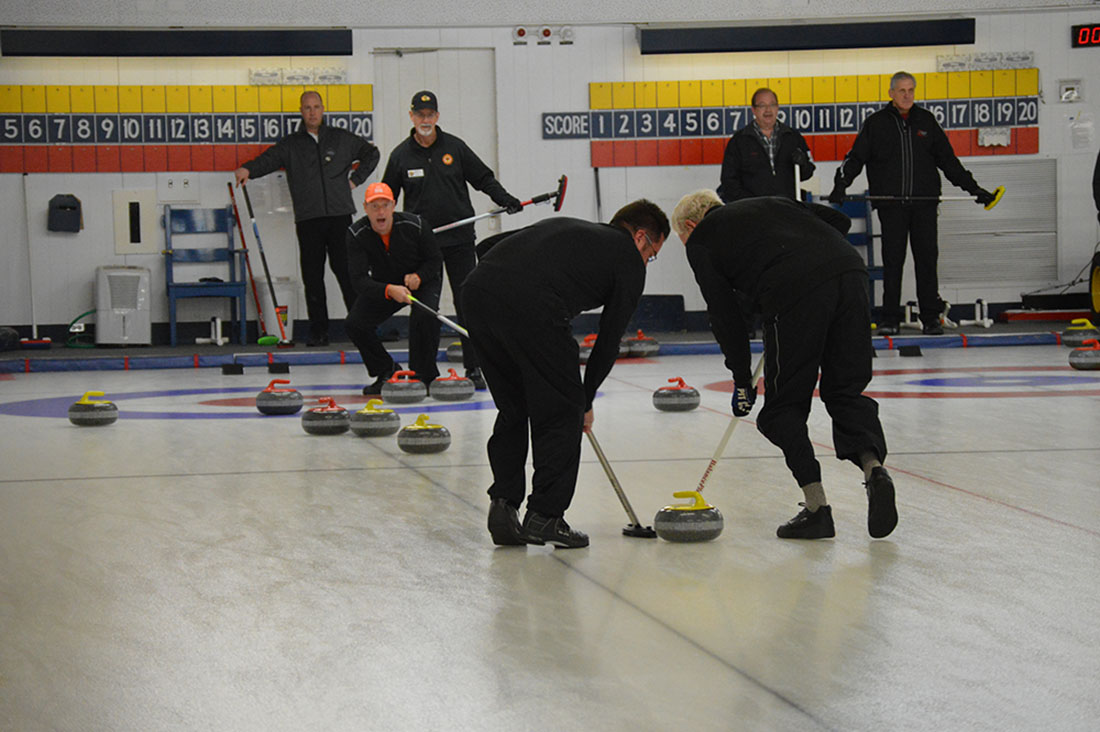By Erin Barney
Mike Rane, a 50-year-old lawyer, kneeled on a long sheet of bumpy ice and shoved a 40-pound granite stone toward a red-and-blue target 114 feet away. Two teammates used brooms to sweep a path for the rock, a fourth monitored its trajectory, and all four yelled at each other to sweep harder and faster.
Welcome to curling—half of it anyway. While they come for the competition, curlers like Rane are often more excited for the off-ice culture. Once the last rock is thrown, opponents let any residual tension from the match fade and bond over a cold one. Or five.
Rane was among 128 men at the 67th Annual Men’s International Bonspiel in Northbrook earlier this month who spent just 45 minutes competing on the ice and several hours in the bar with Canadian challengers.
“I fancied myself an athlete, but I’m sure I was never as good as I thought I was,” Rane said.
“You still aren’t,” one of his Canadian opponents jabbed from across the table.
Their six tablemates laughed and saluted the burn with red Solo cups. They joked as if they’d performed this banter for years. In fact, they met for the first time that afternoon.
“We just beat these guys and they still want to hang out with us,” said Rane, the president of the 250-person Chicago Curling Club. “That’s always how it goes.”
Rane, who has competed at the state level and in the inaugural Olympic curling trials in 1988, said even at the highest level of competition, curlers couldn’t be more cordial.
“It’s a world-wide fraternity,” said Ron Buchanan, a Chicago Curling Club member. “I could go into any curling club in the world, and they’d offer me a beer and a spot on the ice.”
The gentlemanly standard has been part of curling since it debuted Scotland in 1540. Even today, competitors follow the original rituals: a live bagpiper leads the procession of championship-round finalists onto the ice, challengers shake hands before and after matches and complimenting nice shots is an unwritten, but mandatory, expectation.
Good luck relying on audience applause as a clue to the outcome. All competitors, in the sport that resembles a frozen version of shuffleboard, receive a standing ovation from the spectators as they exit the ice.
By definition, the game does not incite a competitive rage toward a rival. No contact or cheap shots are allowed. Rane said the lack of opportunity for “chippiness” keeps emotions in check.
“You can’t play defense,” Rane said. “It’s a unique sport in the sense that there’s nothing you can do when your opponents have the ice.”
“Yes, there is,” a Canadian chipped in. “You just didn’t catch me doing it.”
The response: laughs and another wave of plastic “cheers.”
At the bonspiel (the Dutch term for a curling tournament), it was hard to find a Canadian who didn’t claim to be the best, but the Americans didn’t disagree.
Canadian curlers are royalty on their home turf and are constantly requested for celebrity appearances. The Olympic-caliber players don’t even need a day job—most earn enough to make a living from sponsorship money, often from Tim Hortons, the equivalent of Dunkin’ Donuts in Canada.
However, American curling is on the rise. At the same time a Chicago Curling Club was hoisting the championship cup, team North America was taking home the hardware at the 2016 World Financial Group Continental Cup in Las Vegas.
“We all like to compete,” Rane said. “And the few hours of exercise are great, but the few hours of camaraderie when the game is over are better.”


